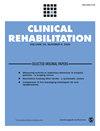The effect of aerobic training on motor function and muscle architecture in children with Duchenne muscular dystrophy: A randomized controlled study
IF 2.6
3区 医学
Q1 REHABILITATION
引用次数: 2
Abstract
Objective To explore the effects of aerobic training adding to home-based exercise program on motor function and muscle architectural properties in children with Duchenne muscular dystrophy. Design This is a prospective randomized controlled study. Setting Pediatric neuromuscular clinic in a tertiary care center. Subjects Children with Duchenne muscular dystrophy. Interventions Children were randomly divided into two groups whereby 12-weeks aerobic training was additionally given in treatment group in contrast to the control group which received only home-based exercise program. Main Measures Motor Function Measure and Six Minute Walk Test were used for clinical evaluation, and muscle architectural properties (thickness, pennation angle and fascicle length) were measured by ultrasound imaging. Both groups were assessed at baseline and after 12-weeks of training. Results Median age of children was 7.9 years in the treatment group and 8.6 years in the control group (p > 0.05). Significant improvements were obtained for Motor Function Measure and Six Minute Walk Test from baseline to 12-weeks in the treatment group; Motor Function Measure total score changed from 83.2 (6.1) to 86.9 (4.0) vs. 82.3 (10.2) to 80.4 (9.4) points in the control group (p = 0.006); 6 Minute Walk Test distance changed from 395.3 (46.6) to 413.0 (52.3) vs. 421.7 (64.4) to 393.8 (68.2) meters in the control group (p < 0.001). However, muscle architectural parameters did not change during study period (p > 0.05). Conclusion Aerobic training may be of additional value in improving motor function and performance with no remarkable effect on muscle architectural properties.有氧训练对Duchenne肌营养不良儿童运动功能和肌肉结构的影响:一项随机对照研究
目的探讨有氧训练与家庭锻炼相结合对Duchenne肌营养不良儿童运动功能和肌肉结构特性的影响。设计这是一项前瞻性随机对照研究。在三级护理中心设立儿科神经肌肉诊所。受试者Duchenne肌营养不良儿童。干预措施将儿童随机分为两组,其中治疗组额外给予12周的有氧训练,而对照组仅接受家庭锻炼计划。主要指标运动功能测量和六分钟步行测试用于临床评估,并通过超声成像测量肌肉结构特性(厚度、束角和束长)。两组均在基线和训练12周后进行评估。结果治疗组和对照组儿童中位年龄分别为7.9岁和8.6岁(p > 0.05)。从基线到12周,治疗组的运动功能测量和6分钟步行测试得到了显著改善;运动功能测量总分从83.2(6.1)分到86.9(4.0)分,对照组从82.3(10.2)分到80.4(9.4)分(p = 0.006);6分钟步行测试距离从395.3米(46.6米)变为413.0米(52.3米),而对照组为421.7米(64.4米)到393.8米(68.2米)(p 结论有氧训练对改善运动功能和运动成绩可能有一定的附加价值,但对肌肉结构特性无显著影响。
本文章由计算机程序翻译,如有差异,请以英文原文为准。
求助全文
约1分钟内获得全文
求助全文
来源期刊

Clinical Rehabilitation
医学-康复医学
CiteScore
5.60
自引率
6.70%
发文量
117
审稿时长
4-8 weeks
期刊介绍:
Clinical Rehabilitation covering the whole field of disability and rehabilitation, this peer-reviewed journal publishes research and discussion articles and acts as a forum for the international dissemination and exchange of information amongst the large number of professionals involved in rehabilitation. This journal is a member of the Committee on Publication Ethics (COPE)
 求助内容:
求助内容: 应助结果提醒方式:
应助结果提醒方式:


